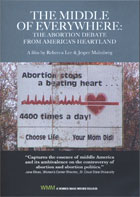
Middle of Everywhere: The Abortion Debate from America’s Heartland 2008
Distributed by Women Make Movies, 462 Broadway, New York, NY 10013; 212-925-0606
Produced by Betrand Faivre
Directed by by Rebecca Lee and Jasper Haimberg
DVD, color, 52 min.
Sr. High - Adult
American Studies, Political Science, History, Popular Culture
Date Entered: 10/21/2010
Reviewed by Charles Burkart, Media Bibliographer, West Virginia University, Morgantown, WVOn the eve of a historic vote in 2006 by the South Dakota legislature to outlaw abortion under House Bill 1215, former resident Rebecca Lee, returns to South Dakota to solicit candid opinions about abortion from state representatives, Planned Parenthood and Right-to Life organizations, as well as the ordinary citizens of South Dakota. Covering a wide diversity of opinion, The Middle of Everywhere, takes you literally to the back roads of rural South Dakota for a frank discussion of this perennially controversial issue.
No easy, simplistic answers are provided in this thoughtful video. South Dakota, a Midwestern Bible Belt state, allows pharmacists and doctors to refuse the dispensation of birth control, and yet House Bill 1215 was defeated by popular vote. The film maker tries to reconcile these seemingly contradictory opinions.
Using scenes of anti-abortion billboards, farm harvester combines and lonesome roads, The Middle of Everywhere: The Abortion Debate from America’s Heartland provides a sort of Midwestern cinema veritée. The film maintains a high level of interest at first, but I felt it lost focus after the climatic rejection of House Bill 1215. In my opinion, the anti-climatic post election examination of Bill 1215 adds little to the structure of the documentary. Extensive, seemingly impromptu, personal interviews were used throughout the film. Sometimes these interviews were recorded under less than optimal conditions. A variety of interesting film shots were used such as aerial, low angle, tracking, and close-ups. Sound was occasionally muffled and neither chapters nor scene selections were offered on my examination copy of the DVD. Music was mostly unobtrusive guitar music, except for a truly awful song used at the film’s end.
I really liked the fair and delicate balance of viewpoints presented in The Middle of Everywhere: The Abortion Debate from Americas Heartland. I feel the director captured the landscape and people of rural South Dakota very well. I can recommend this documentary to both public and academic libraries. It will be of particular interest to educational institutions and public libraries in America’s heartland—particularly in the Dakotas.